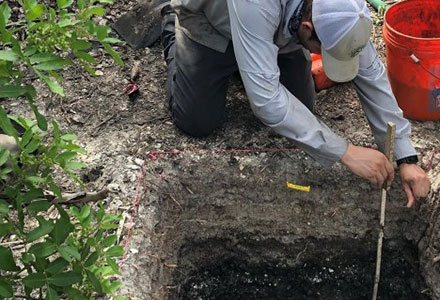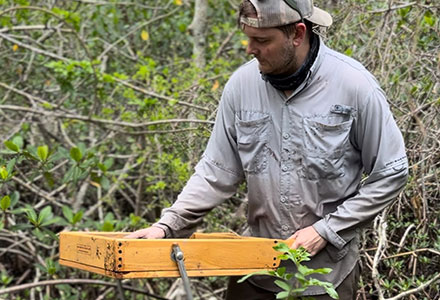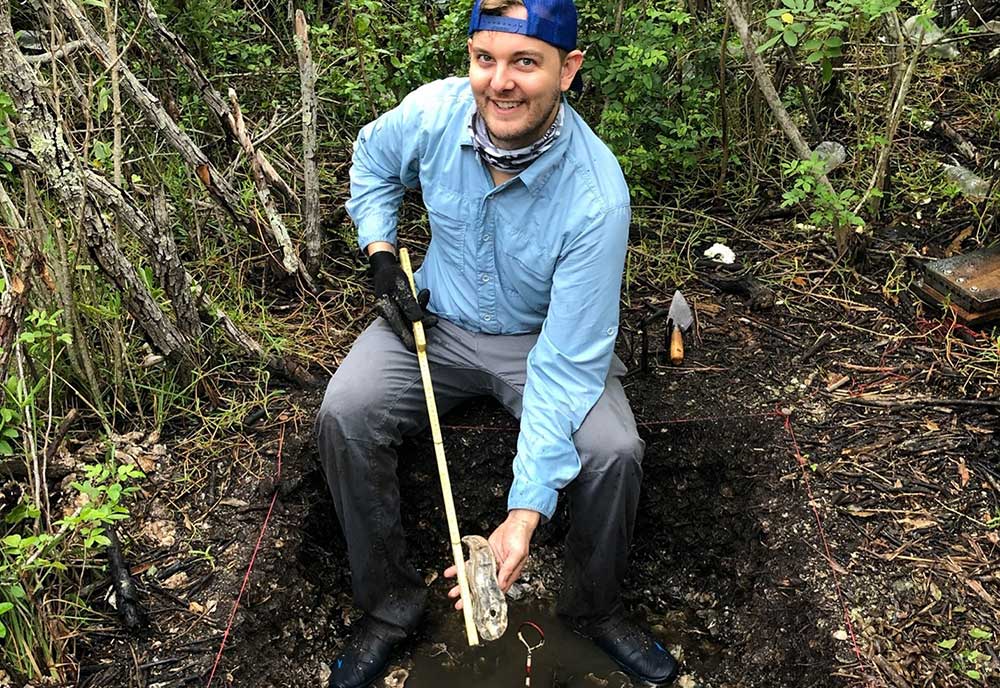Doctoral candidate Jaime Rogers uses scholarship to examine oyster shells and the environmental impact of harvesting and management systems over time
USF College of Arts and Sciences applied anthropology doctoral candidate, Jaime Rogers, is the recipient of the 2023 Freeman Award in Public Archaeology.

Rogers takes a depth measurement of a possible feature in a test unit. (Photo courtesy of Jaime Rogers)
He will use his scholarship funds to further his geochemical analyses of oyster shells from several pre-Columbian sites in Tampa Bay, Florida’s largest estuary, to investigate oyster harvesting patterns and management systems through time.
The scholarship is awarded in memory of John S. Freeman, a USF alumnus who earned his MA in public archaeology posthumously in 2014.
“I’m incredibly grateful to be the recipient of the Freeman award. This area of research matters to me because I was born and raised in Tampa Bay, and I want to contribute to the understanding of its unique history and hopefully its future,” Rogers said.
Rogers said oysters matter for many reasons.
“Whether you eat them or not, oysters are vital to healthy ecosystems and economies. Oysters buffer the impacts of storms, provide food and shelter, and filter water. Tampa Bay, like many estuaries worldwide, has a fraction of the oysters it had just a century ago. My research aims to provide context on their revitalization in hopes to restore these lost ecosystem services,” he said.
Rogers, whose research is currently underway on Florida State Park property, is combining both archaeological and ecological methods to understand how oysters have changed over the past two millennia, the ways in which humans have managed these resources during this time span, and how understanding the trajectory of these changes can inform future management decisions.
To accomplish this, he says, he will compare the size and shape of oysters through time and their chemical signatures to understand the relationships between people and environments over different time scales.
“I am performing small, minimally invasive test units and cores to derive a sample of shellfish, artifacts, sediment, and materials like seeds and charcoal for radiocarbon dating,” he said. “The archaeological oysters are compared to modern oysters sampled by the Florida Fish and Wildlife Research Institute from several environments throughout Tampa Bay.”
Rogers said his research has been steady, with his biggest challenge being conducting fieldwork in intense summer temperatures, but that isn’t stopping him.

Rogers screening sediment through a tiny mesh. This process removes the sediment and retains the shell, animal bones, and artifacts for later analyses. (Photo courtesy of Jaime Rogers)
“I think this research will lead to stronger collaborations between archaeologists and local estuary managers by demonstrating the relevance of long-term baselines in contextualizing environmental issues we face today,” he said.
Rogers said he’s always been interested in how people interact with the environment.
“Anthropology provides a unique way to investigate this topic,” he said. “I was drawn to USF specifically because of its strengths in public-focused archaeology and applied anthropology.”
Upon graduating in the fall 2024 semester, Rogers said he is eyeing a variety of career options including pursuing opportunities in academia, federal jobs such as at the National Park Service, or working for cultural resource management firms.
“Getting to know my peers in the program has helped me expand my perspectives on several topics and broadened my views on the kinds of anthropological research possible,” he said.
